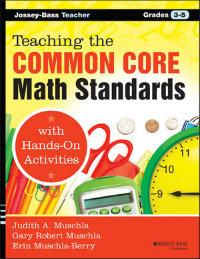Hands-On Activities for Math CCSS Learning
Teaching the Common Core Math Standards with Hands-On Activities: Grades 3-5
By Judith A. Muschla, Gary Robert Muschla, and Erin Muschla-Berry
(Jossey-Bass, 2014 – Learn more)

Let’s be honest. There are countless books being published that profess to be aligned with the Common Core Standards and guarantee you immediate success on any standardized test. In fact, they more or less “promise you the moon.” The sad truth is that more than a few have the disappointment factor built in.

This book is a hands-on approach to supplementing your math repertoire and is aimed at students in grades 3-5. (The same authors have a companion book, published in 2012, for grades 6-8).
The format of the book is broken down into grade levels, with the mathematical domain specified in each lesson. Each activity is preceded by the Domain and Standards it addresses. In addition, each activity includes background information and hands-on/minds-on activities that will challenge and interest almost any student.
You can tell that the book is written by teachers who are currently teaching. The lesson plans are documented with materials, easy-to-follow procedures, and connecting recording sheets. You can easily adapt it to any math program you are currently using and “make it your own.”
Just what students need when they need it
Do you want to take the frustration out of finding developmentally appropriate activities to reinforce concepts you currently teach? This excellent resource has been designed with the student in mind, challenging them appropriately as they acquire a thorough knowledge of key math principles. This, in turn, makes it possible for them to approach new mathematical concepts with confidence and make a smooth transition to higher level mathematical thinking. One of the extra bonuses is a bank of templates that you can use with each lesson, either as is or modified as needed.
Ready, set, collaborate
Learning in the 21st century is not a solitary activity. Students need to learn how to effectively collaborate with others orally, in writing, and through technological avenues. Most of the activities within the book are based upon using classroom partnerships or collaborative groups. Although basic math computation is a prerequisite for the activities, the inquiry based process challenges students to investigate math problems. Students use the inquiry methods to formulate a plan, work together to solve the problem, and share their results and thinking process. Our classes become learning environments where students think, act, and work like mathematicians.
Converting ideas into math centers
There’s an expression that goes “The proof is in the pudding,” which basically means that the quality of something is uncertain until it has been tested directly. Using several lessons from the text, I created math centers to reinforce measurement and data, specifically to convert measurements of larger units into smaller units. (Standard 4.MD.1, 2, 3 Measurement and Data)
My fourth-grade students’ instructions included:
- Explore the relationship of two units of measures according to specific criteria and then create a poster to present your results.
- Work in cooperative groups to solve word problems involving various measurement units and select one of the problems to represent the measurement quantities in the problem on a number line diagram.
- Work in cooperative groups to measure lengths and widths of rectangles in the class, find the areas and perimeters and record them in a table. The data will be used to find the length of an unknown side.
The centers were a success. Students were actively engaged, were able to problem-solve accurately, and had fun! When I asked them to rate the activities on a scale of 1 to 10, the score was a unanimous “10” (some were bordering on giving it an “11”).
An enthusiastic thumbs up
Common Core Math Standards with Hands-On Activities: Grades 3-5 is an important and valuable resource that I would recommend without reservation. It can be used with any existing math program to provide the students in your class with the tools to apply their understanding of math concepts and skills to and become critical mathematical problem solvers. The lessons are engaging, easy to put into practice and based on the current Common Core Standards for Math. Teachers will not only find the lessons easy to implement, but will find themselves just as excited as the students.
Linda Biondi is a fourth grade teacher at Pond Road Middle School in Robbinsville, NJ, and a long-time Morning Meeting practitioner. She’s also the recipient of several educational grants, a Teacher Consultant with the National Writing Project and a participant on the NJ Department of Education Teacher Advisory Panel. She recently shared her thoughts about the Common Core at the NJ SDE website.





























